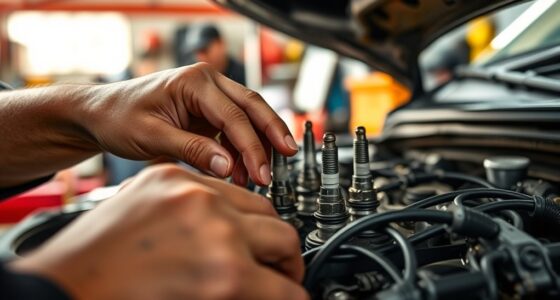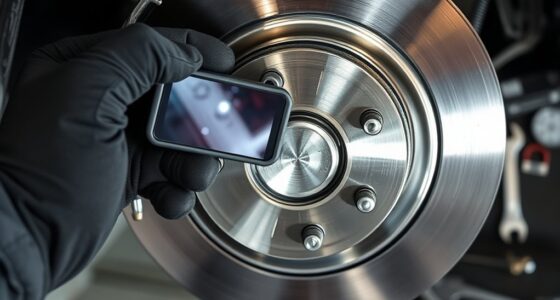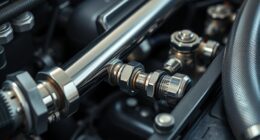ADAS calibration is essential to guarantee your safety systems work correctly after repairs or a collision. It involves verifying that sensors like cameras, radar, and lidar are accurately aligned and positioned according to manufacturer specifications. Proper calibration prevents false alerts and system failures, maintaining your vehicle’s safety features such as adaptive cruise control and lane-keep assist. Understanding the calibration process and methods helps ensure your system functions reliably, and there’s more to learn about the techniques involved.
Key Takeaways
- Proper calibration ensures sensors and cameras are accurately aligned for reliable ADAS operation.
- Calibration involves verifying sensor positions using reference targets and specialized tools.
- Both static (stationary) and dynamic (road testing) methods are essential for comprehensive calibration.
- Manufacturer-specific procedures and equipment are required to ensure correct sensor alignment.
- Accurate calibration maintains safety feature performance, preventing false alerts and hazard detection failures.

Have you ever wondered why proper calibration of Advanced Driver Assistance Systems (ADAS) is crucial after repairs or collisions? When your vehicle undergoes repairs—whether it’s a simple bumper replacement or a more extensive collision—you might assume that fixing the visible damage is enough. However, ADAS components, especially sensors and cameras, need precise calibration to function correctly. Without proper calibration, these systems can become unreliable, potentially compromising your safety and that of others on the road.
One key aspect of ensuring ADAS works properly is sensor alignment. Sensors, such as radar, lidar, and cameras, rely on accurate positioning and orientation to interpret their surroundings correctly. Misaligned sensors can lead to false alerts or, worse, failure to detect hazards like pedestrians, vehicles, or lane markings. That’s why calibration procedures focus heavily on sensor alignment. During calibration, technicians verify that each sensor is correctly positioned relative to the vehicle’s chassis and aligned with other sensors. This process often involves specific reference targets, alignment jigs, and advanced calibration tools to guarantee every sensor points precisely where it should.
Sensor alignment is crucial for ADAS accuracy and safety.
Calibration procedures are more than just adjustments; they are an extensive process that guarantees the entire ADAS system functions as designed. Modern vehicles often require both static and dynamic calibration methods. Static calibration involves setting up the vehicle in a specific environment, using targets and reference points to align sensors accurately. Dynamic calibration, on the other hand, involves driving the vehicle on a designated route to calibrate sensors in real-world conditions, ensuring the systems adapt to actual driving scenarios. Both procedures are essential, especially after impacts that may shift sensor mounts or damage the alignment.
It’s important to follow manufacturer-specific calibration procedures because each vehicle’s ADAS setup can differ greatly. Using the wrong procedures or neglecting to calibrate properly can result in malfunctioning safety features, such as adaptive cruise control, lane-keep assist, or collision mitigation systems. Skilled technicians use specialized diagnostic tools and reference targets to perform these calibrations accurately, making sure every sensor and camera is properly aligned. This not only restores the system’s dependability but also ensures your vehicle’s safety features perform at their best. Additionally, understanding the importance of industry trends can help in selecting the right calibration techniques and equipment for your vehicle.
Frequently Asked Questions
How Often Should ADAS Calibration Be Performed?
You should perform ADAS calibration whenever sensor alignment might be compromised, such as after a collision, windshield replacement, or suspension work. There are no fixed calibration intervals; instead, follow your vehicle manufacturer’s guidelines. Regularly inspect sensors and verify proper calibration to maintain system accuracy. By doing so, you prevent false alerts and guarantee ideal safety features, keeping your vehicle’s ADAS functioning correctly and reliably.
Can I Calibrate ADAS Systems Myself at Home?
Ever wondered if you can do a DIY calibration at home? While it might seem tempting, calibrating ADAS systems at home isn’t recommended because it requires specialized equipment and precise procedures. Home procedures often lack the accuracy needed for proper calibration, risking safety and malfunction. So, instead of risking improper calibration, it’s best to trust professionals who have the right tools and training to guarantee your ADAS system works correctly.
What Are the Signs Indicating Calibration Is Needed?
If you notice sensor misalignment or warning light indicators on your dashboard, it’s a clear sign calibration is required. You might also experience issues with adaptive cruise control, lane-keeping assist, or automatic braking. These symptoms suggest your ADAS sensors aren’t functioning correctly. Don’t ignore these signs; get your system checked and calibrated promptly to ensure your safety features work as intended.
Does Weather Affect ADAS Calibration Accuracy?
Weather can definitely influence ADAS calibration accuracy. For example, heavy rain or snow can interfere with sensor sensitivity, causing false readings. You might notice that your lane departure warning triggers unnecessarily after a storm. To maintain precision, calibration techniques need to account for these conditions. Proper recalibration ensures sensors function correctly, even when weather temporarily impacts sensor performance, keeping your safety systems reliable in all conditions.
Is Calibration Required After Minor Repairs or Only Major Ones?
You should consider calibration necessity after both minor repairs and major ones. Even minor repairs, like replacing a sensor or fixing a fender, can affect ADAS performance. Calibration ensures your system operates accurately and safely. Ignoring calibration after minor repairs might lead to incorrect sensor readings, compromising safety features. As a result, it’s best to follow manufacturer guidelines and have your ADAS calibrated whenever any repair, big or small, could impact sensor alignment or function.
Conclusion
Now that you understand the basics of ADAS calibration, you realize it’s not just a simple task—it’s the key to revealing your vehicle’s full safety potential. Skipping or rushing this process is like leaving your car’s safety net hanging by a thread. When you prioritize proper calibration, you’re not just maintaining your car; you’re safeguarding your life and everyone around you. Never underestimate the power of precise calibration—it’s the difference between safety and catastrophe.









